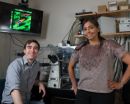(Press-News.org) Flowers aren't just pretty to look at, they are how plants reproduce. In agricultural plants, the timing and regulation of flower formation has economic significance, affecting a crop's yield.
A new paper by researchers at the University of Pennsylvania published in the journal Science has revealed that a plant hormone once believed to promote flower formation in annual plants also plays a role in inhibiting flowers from forming. The dual role of this hormone, gibberellin, could be exploited to produce higher-yielding crop plants.
The study was led by Nobutoshi Yamaguchi and Doris Wagner of the School of Arts and Sciences' Department of Biology. Wagner is professor and graduate chair, and Yamaguchi is a postdoctoral researcher. Department co-authors included Cara M. Winter, Miin-Feng Wu and Ayako Yamaguichi. The Penn team collaborated with Yuri Kanno and Mitsunori Seo of RIKEN Center for Sustainable Resource Science in Japan.
Plant scientists used to think that short-lived plants, annuals or bi-annuals, use a different strategy from long-lived plants, perennials, to regulate flower production.
"Anecdotal evidence was that the hormone gibberellin promoted the switch to flower formation in short-lived plants, along with other cues such as temperature, season and photoperiod," Wagner said. "But in the long-lived plants, like in fruit trees, people have known that if you sprayed them with the hormone it inhibited flower production. So it was a big puzzle: why would the same hormone do one thing in short-lived plants and another in long-lived plants?"
To address this paradox, the Penn team began by looking for new genes important to the flower-forming process. Specifically, they performed a genome-wide search of the plant species Arabidopsis thaliana to find direct targets of the protein LEAFY, which is known to promote flower formation.
One gene that turned up was called ELA1, which produces a cytochrome enzyme and has been shown to play a role in breaking down gibberellin. Further experiments showed that in plants that lost ELA1 function, flowers formed much later than normal.
The researchers also found that plants that lacked LEAFY had high levels of gibberellin, and plants engineered to produce high levels of LEAFY had lower levels of the hormone and were also shorter with greater levels of chlorophyll — characteristics of gibberellin deficiency.
"At first we were confused because gibberellin was supposed to promote all of this activity that leads to flower formation," Wagner said. "Then when we found a direct target of LEAFY that is linked to gibberellin catabolism, that gave us the clue that gibberellin must have a role in inhibiting flower formation as well."
Plants that were genetically modified to not produce gibberellin properly and plants that were treated with a gibberellin inhibitor showed signs of a delayed first transition to inflorescence but accelerated signs of flower formation. Spraying the plants with gibberellin had the opposite effect.
The results suggested that the two transition steps that lead plants to produce flowers might be regulated distinctly, both involving gibberellin. While gibberellin promotes the first transition, in which plants stop producing stems and leaves and produce an inflorescence, it inhibited the second stage, in which flowers were formed.
The mechanism, the Penn team showed, involves rising and then falling levels of gibberellin. High levels cause the plant to end the vegetative phase of development. At that point, LEAFY and ELA1 activity cause gibberellin to break down. Freed from the inhibitory effects of the hormone, a suite of proteins are activated that trigger flower formation.
"When it comes to determining the number of flowers formed and when they are formed, we think this pathway is at the forefront," Wagner said.
Farmers already use gibberellin-deficient breeds of rice to produce more compact plants that don't topple over in wind and rain. The new understanding of gibberellin's role gained from this study could help create plant breeds that are even more productive.
"We think it can be used to enhance yield," Wagner said. "Seeds are the product of a flower so if you want more seed you want more flowers. Being able to modulate the accumulation or degradation of gibberellin could allow one to optimize or enhance the seed set and yield in crop plants."
The Penn team plans to explore other plants to see if gibberellin operates the same way across species and in perennials as well and to further explore how different levels of the hormone trigger regulatory events that either inhibit or promote flower production.
INFORMATION:
The National Science Foundation supported the research.
Plant hormone has dual role in triggering flower formation, Penn study finds
2014-05-08
ELSE PRESS RELEASES FROM THIS DATE:
GaitTrack app makes cellphone a medical monitor for heart and lung patients
2014-05-08
CHAMPAIGN, Ill. — By simply carrying around their cellphones, patients who suffer from chronic disease could soon have an accurate health monitor that warns their doctors when their symptoms worsen.
GaitTrack, an app developed by researchers at the University of Illinois at Urbana-Champaign and the U. of I. at Chicago, turns a smartphone into a sophisticated medical device. Unlike other apps that merely count steps, GaitTrack uses eight motion parameters to perform a detailed analysis of a person's gait, or walking pattern, which can tell physicians much about a patient's ...
Tackling test anxiety may help prevent more severe problems
2014-05-08
Showing students how to cope with test anxiety might also help them to handle their built-up angst and fretfulness about other issues. The results of a new study by Carl Weems of the University of New Orleans show that anxiety intervention programs that focus on academic matters fit well into the demands of the school routine, and do not carry the same stigma among youth as general anxiety programs do. The research group was among the first to study the effects of Hurricane Katrina on community mental health and anxiety among youths, and the paper appears in Prevention ...
Ovarian cancer cells are more aggressive on soft tissues
2014-05-08
When ovarian cancer spreads from the ovaries it almost always does so to a layer of fatty tissue that lines the gut. A new study has found that ovarian cancer cells are more aggressive on these soft tissues due to the mechanical properties of this environment. The finding is contrary to what is seen with other malignant cancer cells that seem to prefer stiffer tissues.
"What we found is that there are some cancer cells that respond to softness as opposed to stiffness," said Michelle Dawson, an assistant professor in the School of Chemical and Biomolecular Engineering ...
Army drug users twice as likely to use synthetic marijuana as regular marijuana
2014-05-08
Social work researchers from the University of Washington have found that among a group of active-duty Army personnel who use illicit drugs, the most abused substance is synthetic marijuana, which is harder to detect than other drugs through standard drug tests.
The research will be published in the July 2014 issue of Addictive Behaviors, but is already online.
Synthetic marijuana, sometimes called "Spice," is made with shredded plant material coated with chemicals that are designed to mimic THC, the psychoactive compound found naturally in marijuana. The U.S. Drug ...
Single cell genome sequencing of malaria parasites
2014-05-08
SAN ANTONIO, May 8, 2014 – A new method for isolating and genome sequencing an individual malaria parasite cell has been developed by Texas Biomed researchers and their colleagues. This advance will allow scientists to improve their ability to identify the multiple types of malaria parasites infecting patients and lead to ways to best design drugs and vaccines to tackle this major global killer. Malaria remains the world's deadliest parasitic disease, killing 655,000 people in 2010.
Malaria parasite infections are complex and often contain multiple different parasite genotypes ...
New genomics technique could improve treatment and control of Malaria
2014-05-08
Single-cell genomics could provide new insight into the biology of Malaria parasites, including their virulence and levels of drug resistance, to ultimately improve treatment and control of the disease, according to new research funded by the Wellcome Trust and the National Institutes of Health.
The findings are revealed in a study by researchers at the Texas Biomedical Research Institute and published today in the journal Genome Research.
Malaria infections commonly contain complex mixtures of Plasmodium parasites which cause the disease. These mixtures, known as multiple ...
Open science journal publishes attempt to reproduce high-profile stem cell acid bath study
2014-05-08
In a study published today in F1000Research, Professor Kenneth Lee of the Chinese University of Hong Kong reveals the full experimental results of an attempt to replicate a controversial study published in Nature recently that suggested that bathing somatic cells in acid can reprogram them to induced pluripotent stem cells (iPS cells). With systematically collected and fully available data, Lee and his colleagues report that carefully replicating the original acid-treatment method does not induce pluripotency in two types of mouse somatic cells, including those used in ...
NASA sees system 90E moving toward southwestern Mexico
2014-05-08
A tropical low pressure area known as System 90E is located a couple of hundred miles southwest of Zihuatenejo, Mexico today and was seen by NASA's Terra satellite on its way to a landfall.
The Moderate Resolution Imaging Spectroradiometer (MODIS) instrument aboard NASA's Terra satellite captured a visible image of System 90E on May 7 at 18:50 UTC/ 2:50 p.m. EDT as it headed to a landfall in southwestern Mexico. The low appeared disorganized as it approached the southwestern coast of Mexico near the states of Michoacan and Guerrero.
According to NOAA's National Hurricane ...
Recycling a patient's lost blood during surgery better than using banked blood
2014-05-08
Patients whose own red blood cells are recycled and given back to them during heart surgery have healthier blood cells better able to carry oxygen where it is most needed compared to those who get transfusions of blood stored in a blood bank, according to results of a small study at Johns Hopkins.
In a report for the June issue of the journal Anesthesia & Analgesia, the researchers say they found that the more units of banked blood a patient received, the more red cell damage they observed. The damage renders the cells less flexible and less able to squeeze through a ...
Few women at high-risk for hereditary breast and ovarian cancer receive genetic counseling
2014-05-08
Mutations in the BRCA1 and BRCA2 genes account for nearly 25 percent of hereditary breast cancers and most hereditary ovarian cancers, yet a study by cancer prevention and control researchers at Virginia Commonwealth University Massey Cancer Center suggests an alarmingly small amount of women who qualify for BRCA genetic counseling actually receive the services. Additionally, they found that a significant proportion of women with a family history of breast and ovarian cancer underestimate their own risk.
The study, published in the April edition of the Journal of Community ...


